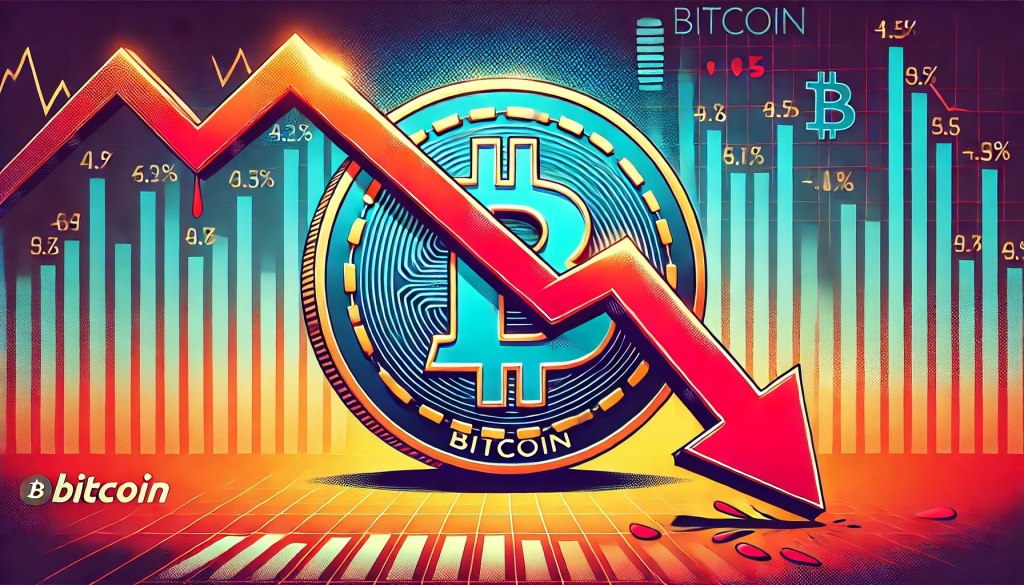Bitcoin Dips Below $96,000 Amidst Economic Uncertainty and Interest Rate Concerns
The cryptocurrency market experienced a downturn on Monday, with Bitcoin (BTC) sliding 0.8% to $95,610.2. This decline came after a 1% weekly drop and marked the first time the digital currency fell below the $96,000 mark since mid-February.
Economic Indicators Fueling Caution
The bearish sentiment in the market was influenced by a few key economic indicators. The Services Purchasing Managers’ Index (PMI) for February dropped to 49.7 from the previous month’s 52.9. This figure suggests that the sector is now in contraction territory, meaning that the rate of expansion in the services sector has slowed down. A PMI reading below 50 indicates a contraction, while a reading above 50 indicates expansion.
Additionally, the Michigan consumer sentiment index reached a 15-month low of 64.7. This index measures the overall attitude of U.S. consumers towards the economy. The figure was lower than the expected 66.5 and marked the lowest reading since March 2021.
Interest Rates and Inflation Concerns
The uncertainty surrounding the U.S. interest rate outlook also contributed to the market’s cautious stance. The Federal Reserve has been considering raising interest rates to combat inflation, which has been on the rise due to various economic factors. The fear of higher interest rates can lead to a decline in the value of riskier assets like cryptocurrencies.
Impact on Individual Investors
For individual investors, the recent dip in Bitcoin’s price might be a cause for concern. Those who have recently entered the market at higher prices may be experiencing losses. However, it’s essential to remember that the cryptocurrency market is known for its volatility, and price fluctuations are a normal part of the investing experience.
It’s crucial for investors to maintain a long-term perspective and not be swayed by short-term market fluctuations. Diversifying your portfolio and investing in a mix of assets can help mitigate risk and provide stability in the face of market volatility.
Impact on the World
The impact of Bitcoin’s dip on the world extends beyond individual investors. Bitcoin’s price movements can influence the broader financial markets and the global economy. For instance, a significant decline in Bitcoin’s price can lead to a sell-off in other risky assets like stocks.
Moreover, Bitcoin’s role as a store of value and a hedge against inflation has gained prominence in recent years. A decline in Bitcoin’s price can dampen investor sentiment towards the cryptocurrency as a hedge against inflation and impact their investment decisions.
Conclusion
In conclusion, Bitcoin’s recent dip below $96,000 was driven by a combination of economic uncertainty and interest rate concerns. The Services PMI and Michigan consumer sentiment index both indicated a slowdown in the economy, while the U.S. Federal Reserve’s potential interest rate hikes added to the market’s caution. Individual investors may experience losses, but it’s essential to maintain a long-term perspective and diversify their portfolios.
The impact of Bitcoin’s price movements on the world extends beyond individual investors. A significant decline in Bitcoin’s price can influence the broader financial markets and the global economy. As always, staying informed and maintaining a well-diversified portfolio is key to navigating the volatile cryptocurrency market.
- Bitcoin dipped below $96,000 on Monday after a 1% weekly drop.
- Economic indicators, including the Services PMI and Michigan consumer sentiment index, fueled uncertainty.
- Interest rate concerns also contributed to the market’s cautious stance.
- Individual investors may experience losses but should maintain a long-term perspective.
- The impact of Bitcoin’s price movements on the world extends beyond individual investors.





